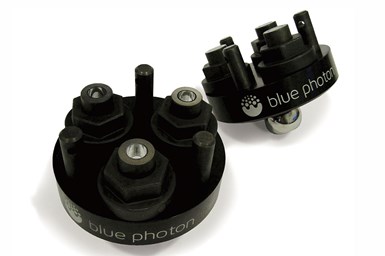Blue Photon Workholding System Simplifies Part Loading
PMTS 2023: The workholding stabilizer puck simplifies how parts are loaded, reducing scrap, enabling faster feed rates and increasing spindle uptime.
The puck is easily adjustable when positioning to grip the part wherever needed to stabilize the workpiece. Photo Credit: Blue Photon
Blue Photon has designed a system using workholding grippers and insert components for use with Big Daishowa and other stabilizer systems. The system holds the workpiece without drilling and tapping into the part or with the need to clamp the part.
The unit is easily adjustable when positioning to grip the part wherever needed to stabilize the workpiece. The unit enables the transfer of loads to the machine table and base. The stabilizer puck simplifies how parts are loaded, reducing scrap, enabling faster feed rates and increasing spindle uptime.
The puck stabilizes the workpiece with its grippers which are inserted into the external fixed inserts. Simply place the puck onto the part where support is needed, turn on the UV light from the Blue Photon controller and the puck will be attached to the workpiece to support it during machining in 60 sec., without modifying the part by adding unnecessary clamping geometry.
The support system is comprised of the puck, adjustable stabilizer arm and base mount. There are multiple base mount options available, including T-slot, threaded hole and even a magnetic mount.
The adhesive workholding process involves applying BlueGrip workholding adhesive to the grippers and curing through the grippers from the backside of the puck base with ultraviolet light for 60 sec. By using grippers on top of the workpiece, users can eliminate drilling and tapping into the part. Part removal is quick and easy with a one-quarter turn twist of the gripper. Residual adhesive is simply removed by using a handheld steamer or a hot water soak and a light peeling action. Any part that is at risk of distortion from traditional clamping or poses complications in fixture design are a potential candidate for the technology.
Related Content
-
5 Aspects of PMTS I Appreciate
The three-day edition of the 2025 Precision Machining Technology Show kicks off at the start of April. I’ll be there, and here are some reasons why.
-
From Shop Floor to Show Floor: PMTS 2025 Delivers
PMTS’ record-setting event builds excitement for its return in 2027.
-
ANCA Tool Grinder Provides Consistent Cutting Tool Production
PMTS 2025: The MX7 Ultra tool grinder is designed to provide micron-level precision, reducing tool runout and optimizing tool life.
















